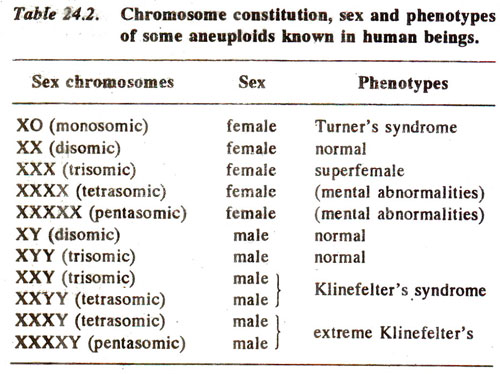Chromosomal aberrations
Triploidy
A solitary case of triploid human being (2n = 69) was reported in 1960 by Brook and Santesson. This triploid individual had three complete sets of autosomes and XXY chromosomes. Consequently, it was a male individual and showed abnormalities in cerebral development, had syndactyly of hands and feet and was small jawed obese. This triploid individual survived only upto birth.
Trisomics (2n = 47) and monosomics (2n = 45) are known in human beings. Trisomy or monosomy may involve a sex chromosome or an autosome.
Aneupioidy involving sex chromosomes. Aneuploid chromosome numbers involving X-chromosome and the resulting phenotypes are listed in Table 24.2.
(a) Turner's syndrome.Turner's syndromes are characterized by monosomy of XO type. These are immature females (sterile) with webbed neck.
(b) Klinefelter's syndrome. Klinefelter's syndromes were characterized by trisomy (XXY).
These are male individuals, who are phenotypically fairly normal but have a very low sperm count and, are therefore sterile. Chromosome constitutions of other Klinefelter's syndromes are given in Table 24.2.
Structural changes. In certain cases of chromosomal aberrations, the chromosome number does not change and remains 2n = 46, but there may be structural changes involved. One of these structural changes may lead to Down's syndrome. In some such cases, it was discovered that extra chromosome 21 (in trisomy 21) was attached to another perhaps acrocentric chromosome of the D group or the G group, so that although it is a trisomic in chromatin content but has a chromosome number 2n = 46. Another translocation 13-22 gives rise to 2n = 45 and leads to delayed development of speech and to a low I.Q.
A large number of other structural changes in the chromosomes leading to a variety of phenotypic effects are known in human beings.





